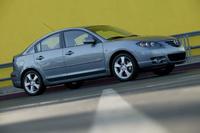IIHS FRONTAL OFFSET CRASH TEST RESULTS: ONLY 2 OF 5 SMALL CARS EARN GOOD RATINGS; 1 IS POOR
(Editor's Note)Tested Cars are linked to full crash report
ARLINGTON, VA December 19, 2004; The IIHS reported that the Mazda 3 is the best performer and the Kia Spectra is the worst in a recent series of frontal offset crash tests conducted by the Insurance Institute for Highway Safety. The Mazda 3 earned a good rating and the added designation of "best pick" for frontal crash protection. The Hyundai Elantra also earned a good overall rating, but only after three tests revealed two design problems that led to recalls. The Suzuki Forenza and Saturn ION are rated acceptable, and the Kia Spectra earned the lowest rating of poor.
"The Kia Spectra's poor performance was a surprise," says Institute chief operating officer Adrian Lund. "Most manufacturers have figured out how to design vehicles to do a good job of protecting people in frontal crashes. Kia lags behind its competitors." The Kia is the first vehicle the Institute has rated poor in a frontal crash test since 2001. The ratings reflect performance in a 40 mph frontal offset crash test into a deformable barrier. Based on the results, the Institute evaluates the crashworthiness of passenger vehicles, assigning each vehicle a rating from good overall to poor. The better performers among the vehicles with good ratings receive the added designation of "best pick." If a vehicle earns a good rating, it means that in a real-world crash of similar severity a belted driver most likely would be able to walk away with only minor injuries. Mazda 3 is top performer: This car is a new design for 2004. It replaces the Mazda Protege, which was rated acceptable for frontal crashworthiness. In the test of the Protege, there was moderate intrusion into the driver's footwell area, which contributed to high forces recorded on the dummy's right leg. There also was some rearward movement of the instrument panel during the crash. "In contrast, the Mazda 3 is one of the best performers in its class in the frontal test," Lund points out. Measures taken from the head, neck, chest, and both legs of the driver dummy indicate low risk of injury. Lund adds that "the Mazda 3's structure held up very well and there was very little intrusion into the occupant compartment. This is the only 'best pick' in this newly tested group of small cars." Hyundai Elantra is tested three times: When the Institute tested the Elantra in 2001, it earned a poor rating mainly because its airbag inflated late, resulting in high forces on the dummy's head. Hyundai redesigned the frontal airbags for the 2004 Hyundai Elantraand asked the Institute to test the car again. "When we tested the 2004 model the airbags worked fine, and at first it looked like a good performer," Lund says. "But there was a major problem. After the crash there was fluid leaking from the gas tank." Hyundai identified a fuel hose clamp that was improperly positioned, which led to the puncturing of the tank during the crash. (Note: A less volatile fluid than gasoline is added to fuel systems in crash tests to allow identification of leaks without the risk of fire.) Hyundai recalled the affected models to reposition the hose clamp and requested the Institute to test an Elantra with the fix. No fluid leaked in this re-test, but the driver airbag failed to deploy. < Hyundai engineers will modify the software that determines whether and when to fire the airbags in 2005 models built after December 2004. The company also will recall cars manufactured earlier to fix this problem. When the Institute tested a third Elantra with the hose clamp and airbag problems fixed, the car performed well. "The structure was good and injury measures for the neck and chest were low," Lund says. "But there was the possibility of a head injury and a right leg injury, so the Hyundai Elantraisn't good enough to be a 'best pick.'" Small car from Kia is a disappointment: "The Spectra has several problems that added up to a poor rating," Lund says. The structure is rated acceptable because of too much intrusion into the driver footwell area. The dummy's head bottomed out the airbag and then went part way out the open side window and hit the door frame. High forces were recorded on the dummy's head, and there were possibilities of injuries to the neck, chest, and both legs."There are many better choices for buyers," Lund says. "Eleven small car designs now earn good ratings in the Institute's frontal offset test, and nine of these also are designated 'best picks.'"
Institute and government crash tests complement each other: The Institute's crashworthiness evaluations are based on results of frontal offset crash tests at 40 mph. Each vehicle's overall evaluation is based on three aspects of performance -- measurements of intrusion into the occupant compartment, injury measures from a Hybrid III dummy positioned in the driver seat, and analysis of slow-motion film to assess how well the restraint system controlled dummy movement during the test. The federal government has been testing new passenger vehicles in 35 mph full-front crash tests since 1978. This New Car Assessment Program has been a major contributor to crashworthiness improvements, in particular improved restraint systems in new passenger vehicles. The Institute's offset tests, conducted since 1995, involve 40 percent of a vehicle's front end hitting a deformable barrier at 40 mph. This test complements the federal test involving the full width of the front end hitting a rigid barrier. Both tests are contributing to improvements in crashworthiness, in particular improved crumple zones and safety cages. The same 40 mph offset crash test is used to evaluate new cars by the European Union in cooperation with motor clubs, by an Australian consortium of state governments and motor clubs, and by a government-affiliated organization in Japan.



